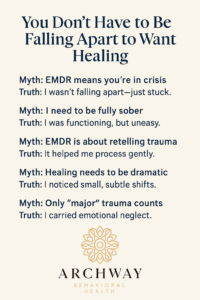You Don’t Have to Be Falling Apart to Want Healing
When I first heard about EMDR therapy, I wasn’t in a crisis. I wasn’t white-knuckling sobriety or falling apart at the seams. I wasn’t even sure I “needed” therapy. I was just… stuck.
I’d cut back on drinking. I was functioning. But underneath, I carried a constant undercurrent of unease—like my nervous system had the volume turned up all the time. I wanted to feel better. I just didn’t know how.
That’s when someone gently asked if I’d ever tried EMDR therapy.
I hadn’t. And to be honest, I didn’t really get it. But something about the idea of healing without having to retell my whole story caught my attention.
So I tried it.
And everything started to change.
Step 1: Realizing the “Problem” Wasn’t Just the Drinking
I’d spent years thinking that alcohol was the issue. And yes, it complicated things. But it wasn’t the core. The deeper problem was the part of me that didn’t feel safe in stillness. The way I’d shut down in conflict. The hair-trigger panic when I sensed rejection, even mildly.
Drinking was a way to dial that down. It made things manageable—until it didn’t.
What EMDR showed me is that my reactions weren’t “dramatic.” They were trauma. Not the kind that makes headlines. But the kind that gets woven into your wiring, shaping how you see the world.
Step 2: Learning What EMDR Therapy Actually Is
EMDR stands for Eye Movement Desensitization and Reprocessing. That sounds clinical—but what it feels like is relief.
In EMDR therapy, your brain gets to do what it was built to do: heal.
Here’s how it worked for me at Archway Behavioral Health:
- We identified a memory or feeling that still felt charged.
- I followed bilateral stimulation (eye movement or tapping) while holding that memory in mind.
- As the session progressed, the emotional intensity faded.
- New insights and sensations surfaced—on their own, without force.
It wasn’t hypnosis. It wasn’t rehashing old pain. It was like unclogging a pipe that had been blocked for years.
Step 3: Letting Go of the Idea That Healing Had to Be Dramatic
Before EMDR, I thought healing meant huge, emotional breakthroughs. Crying on the floor. Having revelations in group therapy. That wasn’t my experience.
With EMDR, healing came in small, subtle shifts. I stopped flinching at certain tones of voice. I started sleeping through the night. I felt less exhausted in conversations. My body wasn’t preparing for danger all the time.
That calm didn’t come from “trying harder.” It came from reprocessing what had never been fully processed before.
Step 4: Understanding That Trauma Doesn’t Have to Be Obvious
I never thought I had trauma. I hadn’t survived war, assault, or natural disaster. But I’d survived emotional neglect. Chronic invalidation. Long periods of pretending I was fine while quietly unraveling.
If that sounds familiar—you might be carrying more than you think.
EMDR is powerful for people like us. People who are sober curious, functional, and quietly hurting. It gives your nervous system a way to breathe again.
Step 5: Feeling the Impact Where It Counts
The most powerful moment came about two months into EMDR. A family argument started—same dynamic, same players. But I didn’t shut down. I didn’t snap. I didn’t feel like I was being emotionally ambushed.
I took a breath. Spoke calmly. Set a boundary.
Afterward, I cried—not from pain, but from relief. Because for the first time in a long time, I didn’t abandon myself in the moment.
Looking for EMDR therapy in Delray Beach, Florida or nearby? Archway’s Boca Raton center has trauma-trained clinicians who get it—and won’t make you start from scratch.

Step 6: Noticing What’s Gone
The tension. The reactivity. The feeling of being hijacked by old memories. I used to live in constant defense mode—preparing for people to leave, blow up, or let me down.
Now? That fear still flickers sometimes, but it doesn’t run the show.
This is what EMDR gave me: the ability to stay present in my life.
And if you’re in Coral Springs or Deerfield Beach and wondering whether you’re ready—you are. You don’t need to be falling apart to want peace.
FAQ: EMDR Therapy and the Sober Curious
Do I have to be sober to begin EMDR therapy?
Not necessarily. Many people begin EMDR while still exploring their relationship with substances. You don’t need to be fully abstinent—just willing to be emotionally present during sessions.
Is EMDR therapy only for “big” trauma?
No. EMDR works beautifully for chronic stress, emotional neglect, bullying, and complex family dynamics—not just single traumatic events.
Will I have to relive painful memories?
No. You’ll revisit them, yes—but EMDR is designed to keep you grounded and safe. You’ll never be forced to go into something you’re not ready for.
How long does it take to feel better?
Some people experience relief within a few sessions. Others take longer. The process is paced to your readiness—not a rigid schedule.
Can EMDR help with anxiety or emotional numbness?
Absolutely. Many clients report that EMDR helps reduce anxiety, panic, shutdown, and even long-standing patterns of detachment.
Final Thought: Healing Doesn’t Mean Erasing—It Means Reconnecting
EMDR didn’t erase my story. It helped me see it differently. With more compassion. Less shame. More context. Less grip.
If you’re wondering whether EMDR therapy could help you, the answer doesn’t have to be loud. A quiet yes is enough.
Especially if you’re tired of performing peace—and ready to feel it.
Take the First Step Toward Something Real
Call (888) 530-0227 to learn more about our EMDR therapy services in Boca Raton, Florida.


